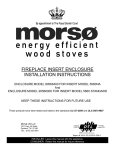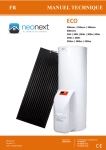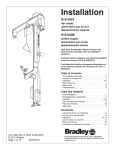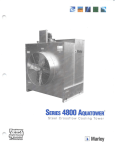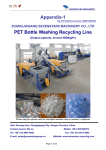Download RAIS INSERT 60 User`s manual
Transcript
RAIS INSERT 60 FIREPLACE INSERT ENCLOSURE INSTALLATION INSTRUCTIONS RAIS A/S Industrivej 20 9900 Frederikshavn Denmark TEL: +45 98 47 90 33 RAIS, Inc. 1011 Highway 52 West Portland, TN 37148 USA TEL: 615-325-1700 MODEL NO: 4034801100 Report #138-S-15-2 INSTALLER: Leave this manual with the appliance. CONSUMER: Retain this manual for future reference. REFER TO THE RAIS INSERT 60 USER’S MANUAL FOR INFORMATION ABOUT OPERATION AND REQUIRED MAINTENANCE FOR YOUR FIREPLACE INSERT. PRODUCT SAFETY THIS FIREPLACE INSERT ENCLOSURE IS A LISTED COMPONENT FOR AND IS INTENDED FOR USE WITH THE RAIS INSERT 60 WOOD-BURNING FIREPLACE INSERT ONLY. DO NOT USE OTHER PRODUCTS NOT SPECIFIED OR LISTED FOR USE WITH THIS ENCLOSURE. WARNING: IF THE ENCLOSURE AND FIREPLACE INSERT ARE NOT PROPERLY INSTALLED, A HOUSE FIRE MAY RESULT. TO REDUCE THE RISK OF FIRE, FOLLOW THE INSTALLATION INSTRUCTIONS EXACTLY. CONTACT LOCAL BUILDING OR FIRE OFFICIALS ABOUT RESTRICTIONS AND INSTALLATION INSPECTION REQUIREMENTS IN YOUR AREA. IT IS A GOOD IDEA TO REVIEW YOUR PLANS WITH THEM BEFORE BEGINNING THE INSTALLATION. ASK YOUR RAIS AUTHORIZED DEALER FOR HELP WITH LOCAL OFFICIALS IF NEEDED. WHEN INSTALLLED IN THIS FIREPLACE INSERT ENCLOSURE, THE RAIS INSERT 60 FIREPLACE INSERT MUST BE CONNECTED TO A CHIMNEY COMPLYING WITH THE REQUIREMENTS FOR TYPE HT CHIMNEYS IN THE STANDARD FOR CHIMNEYS, FACTORYBUILT, RESIDENTIALTYPE AND BUILDING HEATING APPLIANCE, UL-103. IN CANADA, THE INSERT 60 FIREPLACE INSERT ENCLOSURE IS LISTED FOR USE WITH ANY 150MM DIAMETER CHIMNEY SYSTEM TESTED AND LISTED TO THE HIGH TEMPERATURE (650°C) CHIMNEY STANDARD, ULCS-629 WITH A MAXIMUM 12” X 12” (305 MM X 305MM) ANCHOR/ BASE PLATE. WARNING: THIS FIREPLACE INSERT IS NOT A FIREPLACE. BUILDING A FIRE IN THE ENCLOSURE WITHOUT THE RAIS INSERT 60 INSTALLED IS PROHIBITED AND MAY RESULT IN PROPERTY DAMAGE, BODILY INJURY OR EVEN DEATH. SELECTING THE LOCATION FOR YOUR INSTALLATION This insulated metal fireplace insert enclosure enables the RAIS Insert 60 Fireplace Insert to be installed in minimum–clearance situations in locations without an existing masonry fireplace. This could be in new home construction or in homes that are being remodeled. Centrally located installations generally provide and circulate the heat most effectively. An interior chimney is preferred as it will stay warmer and provide a more consistent draft than an exterior chimney. However, many installation options are possible. If an exterior chimney is necessary for your installation, it is recommended that exterior chimney be enclosed in a chase to minimize heat loss. DO NOT CONNECT THIS UNIT TO A CHIMNEY FLUE SERVING ANOTHER APPLIANCE. PLEASE READ THIS ENTIRE MANUAL BEFORE YOU INSTALL AND USE THE FIREPLACE INSERT ENCLOSURE AND RAIS INSERT 60 FIREPLACE INSERT. FAILURE TO FOLLOW INSTRUCTIONS MAY RESULT IN PROPERTY DAMAGE, BODILY INJURY OR EVEN DEATH. FOR FUTHER INFORMATION, REFER TO THE NATIONAL FIRE PROTECTION ASSOCIATION ANSI/NFPA 211 STANDARD FOR CHIMNEYS, FIREPLACES, VENTS AND SOLID FUEL BURNING APPLIANCES OR, IN CANADA, CSA B365. REFER TO THE RAIS INSERT 60 OPERATING INSTRUCTIONS FOR INFORMATION ON THE PROPER USE AND MAINTENANCE OF THE INSERT 60 FIREPLACE INSERT. 2 The Insert 60 Fireplace Insert Enclosure may be elevated off the floor to allow the Insert 60 to be placed higher up on the wall. This will require construction of a base structure to support the enclosure and insert. The base structure should meet the same structural requirements as any other floor construction meeting building code requirements in your area since it is supporting and transferring the appreciable weight of the enclosure and Insert 60 to the floor below it. The surface of the base structure should be covered with a minimum of one layer of ¾ plywood. The distance from the top of the support structure to the ceiling above Insert 60 may be no less than 60 ½” (1537mm). See Fig. 5 on page 5 for support structure information. The face of the support structure should be covered with non-combustible materials only. Simply add the height of the support structure to the non-combustible material height shown in Fig. 6 on page 5. For example: If the support structure is 12” (305mm) high, add 12” (305mm) to the 10 7/8” (276mm) non-combustible limit for the lower portion of the enclosure. CHIMNEY REQUIREMENTS For proper draft and best performance, the chimney should extend at least 15’ (4.6m) and not more than 35’ (10.6m) above the level of the RAIS Insert 60 hearth. The chimney must be properly installed and supported in accordance with the chimney manufacturer’s instructions. The enclosure is not intended to support the entire weight of the chimney. Support components are available from the chimney manufacturer. The chimney installation begins with a base plate or anchor plate mounted to the top of the Fireplace Insert Enclosure. Before the base plate is installed on the enclosure top, the flexible stainless steel flue connector (provided with the enclosure) that will connect the Insert 60 to the chimney system must be attached to the base plate using the four provided sheet metal fasteners. See Fig. 1. Next, insert the anchor plate/flex connector assembly down through the hole in the top of the enclosure. Use the four provided sheet metal fasteners to secure the base/anchor plate to the enclosure top. Next slide the stainless steel 45° slip connector elbow all the way onto the stainless flex connector in preparation for installing the Insert 60. Note: Do not use the black 45° elbow that is shipped with the Insert 60. Chimney Base/ Anchor Plate Sheet Metal Fasteners If possible, an installation with a straight vertical chimney will provide the best draft and will be easiest to clean. Stainless Steel Flex Connector If a straight chimney is not possible due to obstructions, up to four 30° elbows may be used to offset the chimney around the obstructions. The elbows must be used in pairs in order to return the chimney to vertical after passing the obstruction. The first offset must be at least 8’ (2.5m) above the Insert 60 hearth. The Insert 60 Fireplace Insert Enclosure is approved for installation in the United States with the following chimneys: The listed chimney and their manufacturers are: Metal Fab, Inc. Model TG Security Chimneys Model ASHT Selkirk Metalbest Model Ultra-Temp Simpson-Dura-Vent Model Dura-Plus (SDP) In Canada, the Insert 60 Fireplace Insert Enclosure is listed for use with any 150mm diameter chimney system tested and listed to the High Temperature (650°C) Chimney Standard, ULC S-629. NOTE: THE ANCHOR/BASE PLATE DIMENSIONS MAY NOT BE GREATER THAN 305mm X 305mm. Stainless Steel 45° Slip Elbow FIG. 1 COMBUSTIBLE FRAMING The Insert 60 Fireplace Insert Enclosure is designed with spacers on the side and back surfaces that prevent the enclosure walls from coming in contact with adjacent combustible materials that are used for framing around the enclosure. In addition, the top of the enclosure includes a standoff that prohibits the header for the combustible construction above the enclosure from being installed too close the heat from the Insert 60, enclosure top and chimney. Under no circumstances should the spacers or standoff be modified. REDUCTIONS TO ANY OF THE REQUIRED CLEARANCES MAY RESULT IN PROPERTY DAMAGE, BODILY INJURY OR EVEN DEATH. 3 Refer to the adjacent illustration for minimum clearance requirements. Typical framing along with rough framing dimensions are shown in the Figs.2, 3 & 4 on page 5 of these instructions. The actual framing details will vary depending on the placement of your enclosure and Insert 60. It is important to take care when framing to be sure that the area under the enclosure is level and that all framing members are plumb. Forcing the enclosure into a opening that is not level and plumb will cause problems later in the installation process and should be avoided. It is important to note that only nominal 2 X 4 framing materials should be used to frame the area directly above the standoff on the front of the enclosure. This is necessary to prevent combustible framing from encroaching in the space above the enclosure top. We suggest that the framing for the area directly above the standoff on the front of the enclosure be done after the enclosure is secured in place and chimney has been installed. This allows room to work on the chimney and for access for the building inspector. MINIMUM CLEARANCE TO COMBUSTIBLE MATERIALS A 6” 152mm B 1” 25mm C 2” 51mm D 60 ½” 1537mm E 25 ½” 651mm Once the rough framing is completed, the Fireplace Insert Enclosure (with chimney base or anchor plate and flexible vent connector installed) can be slid into the rough opening. Make any last adjustments to center the enclosure in the opening and secure in place with at least four nails using the pilot holes provide in the enclosure front flanges. Countersink the nail heads until they are flush with the front flange surfaces as this will facilitate installation of facing materials later. CHIMNEY INSTALLATION With the Insert 60 Fireplace Insert Enclosure secured to the framing, the chimney system may now be installed. Follow the chimney manufacturer’s instructions exactly including the use of all support hardware, elbows, joist, attic and insulation shields, firestops, flashing kits, storm collars and caps. The safety and functionality of the chimney are critical parts of the installation of the enclosure and Insert 60. After the chimney installation is complete, install the framing above the standoff on the front of the enclosure. This would be a good time to install the required non combustible facing base material to the front of the enclosure. See FIG.6 on page 5 for information on the limits for placement of combustible and non-combustible materials. We recommend that you wait to place any combustible facing materials on any framing until after the installation has been inspected and approved by your local building inspector. 4 RECOMMENDED ROUGH FRAMING DIMENSIONS MINIMUM CLEARANCES TO ADJACENT COMBUSTIBLE MATERIALS Ceiling D D = 60 1/2” (1537mm) Minimum B A Top of enclosure support structure when enclosure is elevated off floor FIG. 2 Framing Front View FIG. 5 Combustible / Non-Combustible Material Limits E = 39 3/8” (1000mm) F = 60 3/4” (1543mm) G = 28 3/4” (730mm) H = 24 1/4” (616 mm) J = 25 5/8” (651mm) K = 10 7/8” (276mm) C Non-Combustible Materials Only E 5 FIG. FIG. 3 Framing Side View J B F G H C K FIG. 6 FIG. 4 Framing Plan View Framing A = 59 5/8” (1515mm) B = 38” (965mm) C = 24 5/8” (626mm) Minimum 5 Spark Protector Strip 2” (51mm) FIG. 7 HEARTH REQUIREMENTS L = 34 1/2” (875mm) Min. M = 16” (405 mm) Min. USA M = 18” (457mm) Min. Canada N = 8” (203mm) Min. When using the Insert 60 in the Fireplace Insert Enclosure, the hearth protection requirements are different than when installing the Insert 60 in an existing masonry fireplace. The enclosure has been designed to elevate the Insert 60 to the minimum distance above the combustible floor where no thermal floor protection is required. However, unless the Insert 60 Fireplace Insert Enclosure will be installed on a completely non-combustible surface such as unpainted concrete over earth, spark and ember floor protection must be provided in front of the insert and enclosure. This will protect the combustible floor in front of the load door from spilled coals or embers. N M FIG. 8 12” (305mm) Max. Depth 24 1/4” (616mm) The floor protector must extend at least 8” (203mm) from the sides of the firebox opening making the minimum total width of the floor protector 34 ½ “ (875mm). In addition, the floor protector must extend a minimum of 16” (406mm) in front of the door opening in the United States and 18” (457mm) in Canada. See Fig. 8. In addition, a 3” X 34 ½” (76mm X 875 mm) sheet metal spark protector strip must be laid under the junction between the front of the enclosure and the floor protector to prevent coals or embers from reaching the combustible floor. See Fig. 7 on page 5. A combustible mantel and any associated trim may be mounted to the wall above the Insert 60. The mantel (or trim) must be a minimum of 24 1/4” (616mm) above the top flange on the Insert 60. See Fig. 9. The mantel may not be deeper than 12” (305mm). CUSTOMIZING THE FINISHED APPEARANCE The facing of the Fireplace Insert Enclosure may be finished to give a variety of different aesthetic appearances. However, only non-combustible materials may be applied to the face inside the specified limits for combustible materials. See Fig 6 on page 5. Outside the combustible limits, any surface finish may be used. For a smooth wall appearance, non-combustible tile 6 N L The floor protector can be made from any completely non-combustible material such as galvanized steel or non-combustible tile backer board. These materials may be covered with decorative non-combustible materials such as ceramic tile. Other non-combustible materials may be used if there are no gaps or joints between pieces that would allow coals or embers to reach the combustible floor underneath. Floor protectors meeting the requirements of UL-1618 Type 1 are acceptable. COMBUSTIBLE MANTEL DOOR OPENING FIG. 9 backer board may be used as a base for plaster allowing a seamless transition beyond the combustible limits to traditional wallboard. For tile, veneer brick or stone, the finish material may be applied over non-combustible tile backer board. The requirements for the facing material applied inside the combustible limits are: The material must be non-combustible. The total thickness, including non-combustible backer board and adhesive should not exceed 13/16” (20mm). Facing materials should not encroach into the front opening in the enclosure in order to allow proper insertion of the Insert 60. Combustible trim at the transition to combustible facing material must not protrude into the room more than ¾” (19mm) from the facing material. If a wood storage compartment is built below the insert enclosure, it should be lined with noncombustible materials. If the wood storage compartment is on the same level as the floor, the floor protection should extend into the entire base of the wood storage compartment. 13/16” (20mm) Max. Non-Combustible Tile Backer Board Insert 60 Flange Combustible Wallboard Non-CombustibleTile 13/16” (20mm) Max. Non-Combustible Tile Backer Board Insert 60 Flange Combustible Wallboard or Metal Lath Prepare the Insert 60 1. After removing the Insert 60 from the shipping enclosure, remove the front door by lifting it off the hinges. Set the door aside. 2. Remove the baffle plate from the firebox by lifting up toward the top of the insert and lift it off the side fireplace insert lining. Turn the baffle at an angle and pull out through the front door opening. Note: The baffle is made of vermiculite material and should be handled carefully to avoid damage. 3. Remove the fireplace insert lining to provide access to the leveling screws. Install the Insert 60 into the Fireplace Insert Enclosure 1. Using a helper or stove lifter, place the insert on the platform inside the enclosure. Push the insert back into the enclosure opening until the insert flange contacts the facing material. Check to be sure the insert is centered in the enclosure opening. 2. Adjust the leveling screws until the face plate is level and plumb or aligned with any joints in the facing material. 3. Replace the fireplace insert lining. 4. Reach up through the flue opening and pull down on the stainless steel 45° slip connector elbow using the handle provided in the elbow. Make sure the connector elbow is full engaged in the insert flue flange. See FIG. 11. 5. Bend the two tabs over to secure the connector elbow. See FIG. 12. 6. Replace the baffle using the reverse order for removal. 7. Replace the door. Chimney Base/ Anchor Plate Plaster Skim Coat FIG. 10 Facing Options Stainless Steel Flex Connector Stainless Steel 45° Slip Elbow Flue Flange FIG.12 Bending Flue Tabs 7 FIG.11 Cutaway View Showing Flue Connection 8








